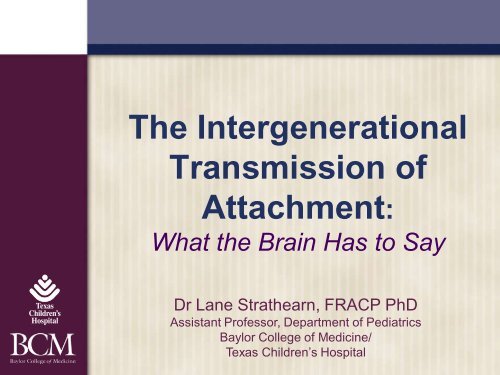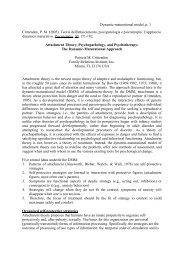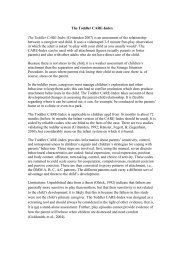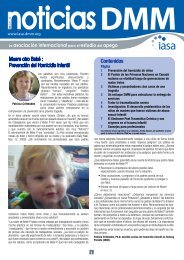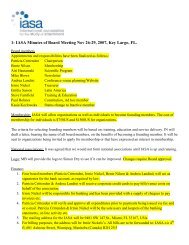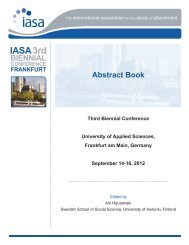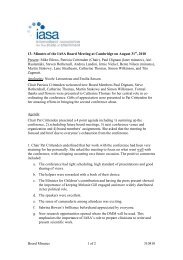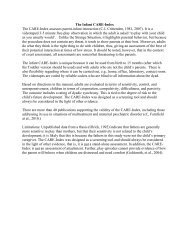The Intergenerational Transmission of Attachment: - IASA
The Intergenerational Transmission of Attachment: - IASA
The Intergenerational Transmission of Attachment: - IASA
- No tags were found...
Create successful ePaper yourself
Turn your PDF publications into a flip-book with our unique Google optimized e-Paper software.
<strong>The</strong> <strong>Intergenerational</strong><strong>Transmission</strong> <strong>of</strong><strong>Attachment</strong>:What the Brain Has to SayDr Lane Strathearn, FRACP PhDAssistant Pr<strong>of</strong>essor, Department <strong>of</strong> PediatricsBaylor College <strong>of</strong> Medicine/Texas Children’s Hospital
Child Neglect• Most prevalent and rapidlyincreasing form <strong>of</strong> childmaltreatment ~40% <strong>of</strong> reported cases are forneglect• Yet, it is the least studied andmost poorly understood type <strong>of</strong>maltreatment
PhysicalNeglectEmotionalNeglect• Failure to provide:FoodClothingShelterMedical careEducational provision• Failure to provide:ComfortProtectionLoveDisciplineEncouragement
Consequences <strong>of</strong>Child Neglect• Impaired cognitive development• Language delays• Increased risk <strong>of</strong> childhoodaggression• Internalizing and externalizingbehavior problems• Increased risk <strong>of</strong> subsequentabuse
<strong>Intergenerational</strong><strong>Transmission</strong> <strong>of</strong> <strong>Attachment</strong>• Overall, there was a 73% match <strong>of</strong>secure/insecure attachmentbetween mothers and infants (Χ 2 = 10.7,df = 1, κ = 0.46, p = 0.001)
<strong>Intergenerational</strong><strong>Transmission</strong> <strong>of</strong> <strong>Attachment</strong>65%29%Shah, Fonagy, Strathearn, 2010
<strong>Intergenerational</strong><strong>Transmission</strong> <strong>of</strong> <strong>Attachment</strong>65%29%• Increased likelihood <strong>of</strong> inversion <strong>of</strong>patterns across Type A and C groups
<strong>Intergenerational</strong><strong>Transmission</strong> <strong>of</strong> <strong>Attachment</strong>MOTHER’SATTACHMENTSTRATEGYINFANT’SATTACHMENTSTRATEGY
<strong>Intergenerational</strong><strong>Transmission</strong> <strong>of</strong> <strong>Attachment</strong>“TRANSMISSION GAP”MOTHER’SATTACHMENTSTRATEGYMaternal sensitivityor “sensitiveresponsiveness”?Mentalizing?INFANT’SATTACHMENTSTRATEGYGeneticfactors?
<strong>Intergenerational</strong><strong>Transmission</strong> <strong>of</strong> <strong>Attachment</strong>MOTHER’SATTACHMENTSTRATEGYINFANT’SATTACHMENTSTRATEGY
DOPAMINESYSTEMOXYTOCINSYSTEMPituitary GlandPeripheral blood
Maternal Behavior in the Rat• Pup vocalization• Licking andgrooming• Arched-back nursingChampagne, 2003
Oxytocin and DopamineSystems• Oxytocin “affiliation” pathways Pituitary gland Hypothalamus (MPOA, PVN)• Dopamine “reward” pathways Ventral striatum Medial prefrontal cortex• <strong>The</strong> development <strong>of</strong> these systemsappears to be strongly influenced by earlymaternal care
Neuroendocrine Systems Importantin Maternal Behavior1. Dopamine (DA)• Nucleus accumbens - DAimportant in rat maternalbehavior and releasedduring mother-pupinteraction• Important factor in cognitivedevelopment andestablishing reward-basedcontingencies2. Oxytocin• Central hormone critical for the social andmaternal behavior,• Social memory;• Anxiolytic properties
Oxytocin and maternalcaregiving• In animal models <strong>of</strong> maternal care,oxytocin is critical for the initiation <strong>of</strong>maternal care• In ewes, oxytocin results in selectivebonding with the lamb• Oxytocin neurons may also connectwith the brain’s dopamine “reward”system, resulting in changes in “longtermconditioned preferences”
Oxytocin and maternalcaregiving• Oxytocin is a peripheral hormoneimportant in childbirth and lactation• Breastfeeding/suckling stimulates itsproduction• It also has important central effects inthe brain to help prepare for longtermchild rearing• “Calm and connection” effect
DNA Methylation and Epigenetics• Early life somatosensory stimulation(“pup licking”) results in: Change in methylation pattern at stressreceptor gene, resulting in a reducedstress response Change in methylation pattern forestrogen receptor gene, resulting inchanges in oxytocin functioning, andenhanced maternal caregiving behavior infemale <strong>of</strong>fspring Enhanced dopamine production inresponse to infant cues
<strong>Intergenerational</strong><strong>Transmission</strong> <strong>of</strong> <strong>Attachment</strong>MOTHER’SATTACHMENTSTRATEGYINFANT’SATTACHMENTSTRATEGY
<strong>Intergenerational</strong><strong>Transmission</strong> <strong>of</strong> <strong>Attachment</strong>MOTHER’SATTACHMENTSTRATEGYINFANT’SATTACHMENTSTRATEGY
Study OutlineVisit 1:PregnancyVisit 2:VideotapingVisit 3:ScanningVisit 4:Follow-Up3 rd trimester 7 mths 10 mths14 mthsStudyTimelineBIRTH20 min 5 min 6 min 20 minMother-infantseparation 1“Free play”interactionMirror-basedinteractionMotherinfantseparation 2DataCollected•AAI•Demographics•PDQ•BDI•PANAS (1)•Demographics•ATQ•Infant faceimagesBlood draws•Oxytocin•Cortisol•Adrenaline•Noradrenaline•PANAS (2)•IBQ•PSI•WTAR•Breastfeedingduration•Hours separatedper week•Bayley Scales<strong>of</strong> InfantDevelopment•StrangeSituationProcedureStrathearn L, et al. Neuropsychopharmacology. 2009.
Visit 1: PregnancyVisit 1:PregnancyVisit 2:VideotapingVisit 3:ScanningVisit 4:Follow-Up3 rd trimester 7 mths 10 mths14 mthsStudyTimelineBIRTH20 min 5 min 6 min 20 minMother-infantseparation 1“Free play”interactionMirror-basedinteractionMotherinfantseparation 2DataCollected•AAI•Demographics•PDQ•BDI•PANAS (1)•Demographics•ATQ•Infant faceimagesBlood draws•Oxytocin•Cortisol•Adrenaline•Noradrenaline•PANAS (2)•IBQ•PSI•WTAR•Breastfeedingduration•Hours separatedper week•Bayley Scales<strong>of</strong> InfantDevelopment•StrangeSituationProcedureAAIStrathearn L, et al. Neuropsychopharmacology. 2009.
Visit 2: VideotapingVisit 1:PregnancyVisit 2:VideotapingVisit 3:ScanningVisit 4:Follow-Up3 rd trimester 7 mths 10 mths14 mthsStudyTimelineBIRTH20 min 5 min 6 min 20 minMother-infantseparation 1“Free play”interactionMirror-basedinteractionMotherinfantseparation 2DataCollected•AAI•Demographics•PDQ•BDI•PANAS (1)•Demographics•ATQ•Infant faceimagesBlood draws•Oxytocin•Cortisol•Adrenaline•Noradrenaline•PANAS (2)•IBQ•PSI•WTAR•Breastfeedingduration•Hours separatedper week•Bayley Scales<strong>of</strong> InfantDevelopment•StrangeSituationProcedureAAI
Visit 3: fMRI ScanningVisit 1:PregnancyVisit 2:VideotapingVisit 3:ScanningVisit 4:Follow-Up3 rd trimester 7 mths 10 mths14 mthsStudyTimelineBIRTH20 min 5 min 6 min 20 minMother-infantseparation 1“Free play”interactionMirror-basedinteractionMotherinfantseparation 2DataCollected•AAI•Demographics•PDQ•BDI•PANAS (1)•Demographics•ATQ•Infant faceimagesBlood draws•Oxytocin•Cortisol•Adrenaline•Noradrenaline•PANAS (2)•IBQ•PSI•WTAR•Breastfeedingduration•Hours separatedper week•Bayley Scales<strong>of</strong> InfantDevelopment•StrangeSituationProcedureAAI
Visit 4: Follow-UpVisit 1:PregnancyVisit 2:VideotapingVisit 3:ScanningVisit 4:Follow-Up3 rd trimester 7 mths 10 mths14 mthsStudyTimelineBIRTH20 min 5 min 6 min 20 minMother-infantseparation 1“Free play”interactionMirror-basedinteractionMotherinfantseparation 2DataCollected•AAI•Demographics•PDQ•BDI•PANAS (1)•Demographics•ATQ•Infant faceimagesBlood draws•Oxytocin•Cortisol•Adrenaline•Noradrenaline•PANAS (2)•IBQ•PSI•WTAR•Breastfeedingduration•Hours separatedper week•Bayley Scales<strong>of</strong> InfantDevelopment•StrangeSituationProcedureAAIBRAIN / BEHAVIORSSP
Three Affective StatesCrying Neutral Smiling
2 sec2 sec2 secOwn:Happy(OH)Unknown:Happy(UH)Unknown:Sad(US)2 sec2 sec2 sec2–6 sec randominter-stimulusintervalOwn:Neutral(ON)Unknown:Neutral(UN)Own:Sad(OS)
2 sec2 sec2 secAFFECTSTIMULUSTYPESHappyNeutralSadIDENTITYOwnInfantOHONOSUnknownInfantUHUNUSOwn:Happy(OH)Unknown:Happy(UH)Unknown:Sad(US)2 sec2 sec2 sec2–6 sec randominter-stimulusintervalOwn:Neutral(ON)Unknown:Neutral(UN)Own:Sad(OS)
Functional MagneticResonance Imaging (fMRI)fMRI allows for the time course <strong>of</strong> human brain activity tobe imaged.
<strong>The</strong> Hemodynamic ResponseNeural pathwayHemodynamicsMR scannerFigure adapted from Chein & Schneider
Initial FindingsVentral striatumCingulate CortexSubstantia nigraVTAn=28, p
A. Dorsal striatumB. Substantia nigra
A. Dorsal striatumB. Substantia nigra
fMRI response (% BOLD signal +/- se)A. Dorsal striatumHAPPY0.40.30.2***0.10-0.1-0.2-0.3-0.4Time (sec)Own baby faceUnknown baby faceB. Substantia nigra
fMRI response (% BOLD signal +/- se)A. Dorsal striatumHAPPYNEUTRAL0.40.30.20.1*** *0-0.1-0.2-0.3-0.4Time (sec)Own baby faceUnknown baby faceB. Substantia nigra
fMRI response (% BOLD signal +/- se)A. Dorsal striatumHAPPY NEUTRAL SAD0.40.30.20.1*** *0-0.1-0.2-0.3-0.4Time (sec)Own baby faceUnknown baby faceB. Substantia nigra
fMRI response (% BOLD signal +/- se)A. Dorsal stiatumHAPPY NEUTRAL SAD0.40.30.20.1*** *0-0.1-0.2-0.3-0.40.40.30.2***0.10-0.1-0.2-0.3-0.4-4 -2 0 2 4 6 8 10 12Time (sec)B. Substantia nigraOwn baby faceUnknown baby face
fMRI response (% BOLD signal +/- se)A. Dorsal striatumHAPPY NEUTRAL SAD0.40.30.2*** *0.10-0.1-0.2-0.3-0.40.40.30.2****0.10-0.1-0.2-0.3-0.4-4 -2 0 2 4 6 8 10 12 -4 -2 0 2 4 6 8 10 12Time (sec)B. Substantia nigraOwn baby faceUnknown baby face
fMRI response (% BOLD signal +/- se)A. Dorsal striatumHAPPY NEUTRAL SAD0.40.30.2*** *0.10-0.1-0.2-0.3-0.40.40.30.2****0.10-0.1-0.2-0.3-0.4-4 -2 0 2 4 6 8 10 12 -4 -2 0 2 4 6 8 10 12Time (sec)-4 -2 0 2 4 6 8 10 12B. Substantia nigraOwn baby faceUnknown baby face
<strong>Attachment</strong> <strong>The</strong>ory• Originally formulated by JohnBowlby in 1969• Innate biological system to ensureprotection and reproduction• Individual differences in attachment“security” are associated withmaternal care and infantsocial/emotional development
Group Comparisons• Comparison <strong>of</strong> 15 “secure” mothers and15 “insecure/dismissing”• No significant group differences wereseen, with respect to: Maternal SES, race, education or IQ Self-reported parenting stress Pre- or post-natal depression orpsychopathology risk Mother or infant temperament Infant development at 14 months Breastfeeding duration
Secure vs.Insecure/DismissingSECURE Medial PFC Orbit<strong>of</strong>rontalcortex Ventral striatumINSECURE /DISMISSING Dorsolateral PFC
% Signal Change% Signal ChangeOwn Happy Faces:Secure vs. Insecure <strong>Attachment</strong>BilateralVentralStriatumVS54321(se=1.0, t=3.0, p=0.006)0y=11-1SecureInsecure/DismissingmPFC1.51(se=0.4, t=3.1, p=0.005)0.5RightMedialPFCx=-60-0.5-1-1.5SecureInsecure/DismissingStrathearn L, Fonagy P, Amico J, Montague PR. Adult attachment predicts maternal brain and oxytocin response to infant cues. Neuropsychopharmacology. 2009. [Epub ahead <strong>of</strong>print].
Secure vs.Insecure/DismissingSECURE Medial PFC Orbit<strong>of</strong>rontalcortex Ventral striatum Ventral striatumINSECURE /DISMISSING Dorsolateral PFC Dorsolateral PFC Anterior insula
Strathearn L, Fonagy P, Amico J, Montague PR. Adult attachment predicts maternal brain and oxytocin response to infant cues. Neuropsychopharmacology. 2009. [Epub aheadprint].% Signal Change% Signal ChangeOwn Sad Faces:Secure vs. Insecure <strong>Attachment</strong>1.4R VentralStriatumVSVS1.210.80.60.4(se=0.4, t=3.1, p=0.005)0.20-0.2-0.4y=11y=11-0.6SecureInsecure/DismissingInsula1.210.8(se=1.0, t=3.0, p=0.006)0.60.4R Insula0.20-0.2y=17x=-6-0.4SecureInsecure/Dismissing
(pg/ml) Serum oxytocinChange in peripheral oxytocinwith mother-infant interaction2.32.11.91.7*Type B (Secure)Type A(Insecure/Dismissing)1.51.31.1* P
Own > Unknown Faces:Oxytocin ResponseHypothalamus/Pituitary Region>Hypothalamus/Hypothalamus/Pituitary RegionPituitary Regionr s =0.60,P=0.001(-3,2,-16)Strathearn L, Fonagy P, Amico J, Montague PR. Adult attachment predicts maternal brain and oxytocin response to infant cues. Neuropsychopharmacology. 2009. [Epub ahead <strong>of</strong>
Oxytocin Response andVentral Striatum ActivationVentralStriatumactivationStrathearn L, Fonagy P, Amico J, Montague PR. Adult attachment predicts maternal brain and oxytocin response to infant cues. Neuropsychopharmacology. 2009. [Epub ahead <strong>of</strong> print].
Adjusted frequency <strong>of</strong>attuned vocalizationsMarked, attuned non-imitativematernal vocalizations
Adjusted frequency <strong>of</strong>attuned vocalizationsMarked, attuned non-imitativematernal vocalizations
Modified Still-Face
<strong>Intergenerational</strong><strong>Transmission</strong> <strong>of</strong> <strong>Attachment</strong>• Type B mothers Have increased dopamine rewardresponses in the brain on seeingtheir infant’s face Have increased oxytocin responseon interacting with their infant Are more attuned in their vocalcommunication with their infantAre more likely to have Type Bchildren
• Type A mothers Have decreased dopamine rewardresponses in the brain on seeing theirinfant’s happy face Have insula activation in response to theirinfant’s crying face Have less oxytocin response oninteracting with their infant Are less attuned in their vocalcommunication with their infant<strong>Intergenerational</strong><strong>Transmission</strong> <strong>of</strong> <strong>Attachment</strong>Are more likely to have Type C children
Future Directions: ExploringEmotional NeglectR I S K F O R E M O T I O N A L N E G L E C TInsecure/DismissingAdult <strong>Attachment</strong>Dopamine andoxytocinEFFECTS OFINTRANASALOXYTOCINMaternal Responses toInfant Cues1.Brain•Functional MRI•Eye gaze tracking2.Behavior•Videotaped free play•Modified Still-Face paradigmIndirect Measures <strong>of</strong> Maternal Emotional Neglect•Reduced brain reward activation to infant faces•Reduced eye gaze when viewing sad infant faces•Reduced maternal sensitivity•Reduced contingent responses to infant cues
Acknowledgements• Dr Michael O’Callaghan, Pr<strong>of</strong> Jake Najmanand the Mater-University Study <strong>of</strong> Pregnancy• Peter Fonagy, UCL• Families, Youth and Community CareQueensland, Australia• Child Protection Information Systems,Brisbane, Australia• Read Montague, Samuel McClure at theHuman Neuroimaging Laboratory, BaylorCollege <strong>of</strong> Medicine


